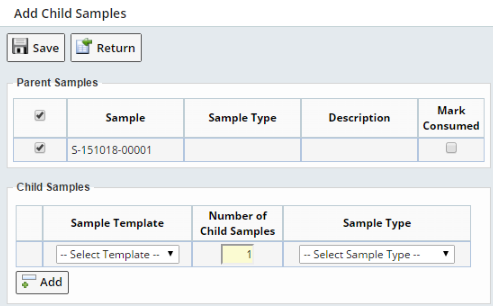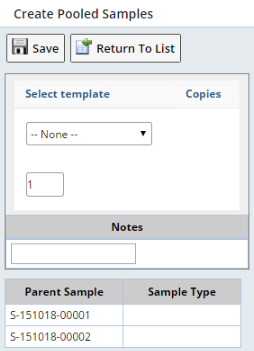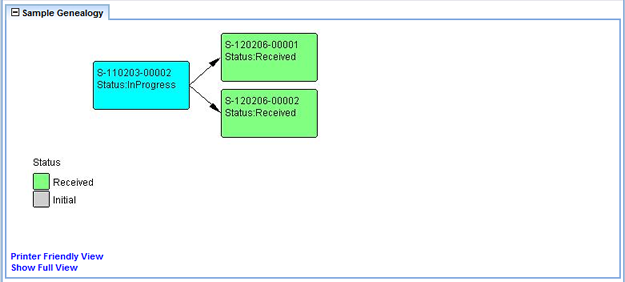Within LabVantage there are several opportunities for creating new Samples
from existing Samples. In BioBanking, you create Aliquots and Derivatives
and define how the remaining Parent Sample volume will be determined. In non-BioBanking
Samples, you are splitting existing Samples and determining whether or not
the Parent Sample has been consumed and, if so, whether or not to delete it
automatically. You also have the option to Pool existing Samples into a single
composite Sample (BioBanking), or one/many new Samples (non-BioBanking).
Options in Biobanking:
| Option |
Description |
| Aliquoting
|
Split existing samples to create new Sample(s) with a
specific quantity, Unit, and Sample Template. The volume of the parent
Samples are decremented based on the quantity of children and volume of
each child created. |
| Derivatives
|
Split existing samples to create new Sample(s) with a
specific quantity, Unit and Sample Template. The volume of the parent
Samples are decremented to the value provided in the "Remaining Quantity"
field. |
| Pooling
|
Pooling is the act of combining multiple Samples into a
single, composite Sample. Select any number of Samples of the
same Sample Type and pool them together to create a new Sample. |
Options for non-biobanking Samples:
| Option |
Description |
| Add Child
|
When adding (splitting) Child Samples you can define the
number of new Samples to add and associate the Samples with a Sample Template
and Type. You can optionally define whether or not the Parent Sample was
consumed by the split. |
| Pool Samples
|
Pooling Samples allows you to Pool multiple Samples into
one or many new Samples. Define the number of new Samples to create from
the Pooled Samples and optionally associate the Samples with a Sample
Template. |
In this section we will focus on creating non Biobanking Samples, for detailed information about Biobanking Samples see Biobanking Samples Operations.
Adding Child Samples (or splitting) allows you to create one or more new
Sample(s) from existing Samples. Access the Add Child button from the Sample
List Page.
See Manage for detailed information about the Sample List page.
Select the Sample(s) you want to Split and click the "Add Child Samples"
button. Select multiple samples when you want to create the same number of
new Samples for each selected sample, all having the same Sample Templates
and Types.
The Add Child Samples window opens.

Parent Samples Tab
The Parent Samples tab displays information about the original or Parent
Sample. Checking the Mark Consumed box determines whether or not the entire
Parent Sample was used to create the Child Samples. Your decision in MultiSampleChild
Page Type, Parent Deplete Properties field will determine whether or not the
Parent Sample will be marked "Disposed" when Split and the Marked
Consumed field is checked. See MultiSampleChild
Page Type for more information about configuring the Parent Samples Tab.
Child Samples Tab
The Child Samples tab allows you define the new Samples.
| Field |
Description |
| Sample Template |
The Sample Template to associate with this Sample. The values available may be determined by values defined in the MultiSampleChild Page Type. |
| Number of Child Samples |
The number of Child Samples to create from the original Parent Sample with the same Sample Template and Sample Type. |
| Sample Type |
Define the Sample Type. |
| Add Button |
Clicking the "Add" button adds another line where you can Add multiple Samples with different Sample Templates or Types. |
Clicking "Save" creates the three new Sample(s) and displays them
in the Sample List page. New Samples will have the same status as their Parent
Samples(s). For example if the Parent's status was "Received" the
new Samples will also have a status of "Received". In this case
the Parent Sample and new Child Sample's status is "Initial". The
 Child Sample Icon displays in the Sample List to identify these as Child Samples.
Child Sample Icon displays in the Sample List to identify these as Child Samples.
Pooling Samples allows you to Pool multiple Samples into one or many new Samples. Define the number of new Samples to create from the Pooled Samples and optionally associate the Samples with a Sample Template. Access the Pool Samples button from the Sample List Page.
See Manage for detailed information about the Sample List page.
Select the Samples you want to Pool together and click the "Pool Samples"
button. The Create Pooled Samples window displays.

The Parent Samples are listed. Define the following for the new Sample(s).
| Field | Description |
| Select Template | The Sample Template to associate with this Sample. The values available may be determined by values defined in the MultiSampleChild Page Type. |
| Copies | Define the number of Samples to create from these Parent Samples. |
| Notes | Enter any notes regarding these Samples. |
Clicking "Save" creates the new Sample(s) and displays them in the
Sample List page. Any common information (between parents) is copied to the Pooled Sample Family. New Pooled Samples will always have a status of Initial regardless
of the Parent Sample's Status. The  Pooled Sample Icon displays in the Sample List to identify these as Pooled Samples.
Pooled Sample Icon displays in the Sample List to identify these as Pooled Samples.
| |
| |
Identifying Split or Pooled Samples | |
| |
| |
When a Sample has been Split or Pooled the following icons will display in
the Sample list page.
| Icon | Description |
 | The original Sample that was used to create Split or Pooled Samples. |
 | Pooled Samples |
 | Split (Child) Samples |
Viewing Parent Child Relationships
Clicking on the icons in the Sample List Page displays the Sample Genealogy Viewer where you can see all of the parent child relationships graphically.

| |
| |
Configuring Add and Pool Samples | |
| |
| |
When Adding or Pooling Samples, there are several system-level decisions made
to determine functionality. See MultiSampleChild
Page Type and CreatePooledSample
Page Type for detailed information on these decisions.


